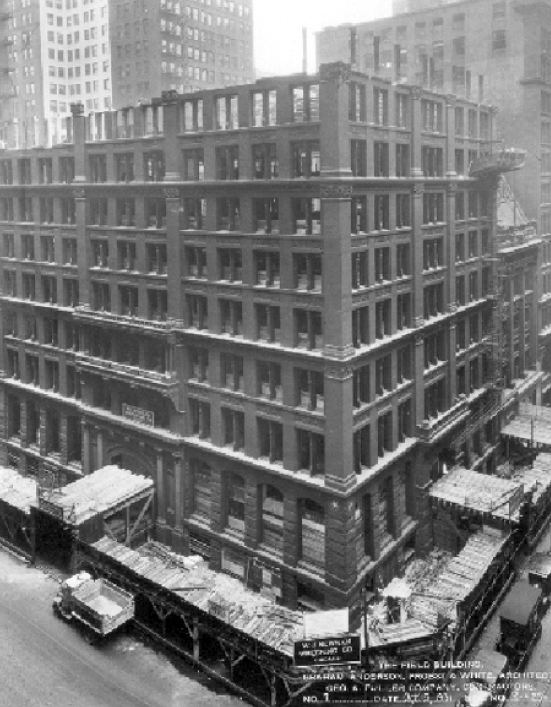Table of Content
In September 1929 plans were made by Marshall Field's to construct a large office building spanning Adams, Clark, and LaSalle Streets. This building would be constructed and opened in parts, the first part occupying the western part of the lot and the site of the Home Insurance Building. The building weighed one-third as much as a masonry building and city officials were so concerned they halted construction while they investigated its safety.

He was told to provide the maximum number of small offices above the second floor. He saw at a glance that neither brick nor stone would carry the load per unit of section. Architects often had built iron columns into masonry piers where the load was exceptionally great, and Mr. Jenney had done the same thing in the Fletcher & Sharo building at Indianapolis. The material solution of the problem was to make this construction general, and inclose an iron column within each of the small masonry piers, thus satisfying the three requirements—small piers, strong and fireproof.
When Was The Home Insurance Building Built
The structure was one of Chicago’s first skyscrapers and played an important role in the city’s skyline development. The building served as a symbol of Chicago’s growth and progress, and it will always be remembered as one of the city’s most significant landmarks. Jenney’s achievement paved the way for the work of a group of architects and engineers that would become known as the Chicago School; together, they would develop the modern skyscraper over the last years of the 19th century and the first years of the 20th. Several important members of this group worked at one time in Jenney’s office, including Daniel Burnham (who would go on to design New York City’s iconic Flatiron Building), John Root and Louis Sullivan.

It is also the world’s tallest skyscraper, with elevators installed inside it. For Instance, it has been stated that the masonry of an intermediary story could be removed without the masonry of the floors above falling out, giving indication of skyscraper wall construction. Masonry is carried on lintel beams which are supported by mullion columns, which are in turn supported two or three floors apart by rolled shapes. The host of architects and others who are studying this building as it melts away under the picks of the wreckers are seeking to determine once and for all its claim to fame as the first structure of skyscraper construction- ever to be erected In the world. The popular definition of a skyscraper is said to be a building of skeleton framework, with the outer walls hung onto and carried by the framework instead of supporting themselves as under construction methods carried on down through the ages. The architects and builders of Chicago planned this week to design and have cast a bronze tablet in memory of Mr. Jenney, which is to be placed on the wall of the Home Insurance building, the first skeleton construction building in the world.
What Do You Think Is The Significance Of The Home Insurance Building In Chicago?
The story of how Jenney saved a section of Grant’s army at Shiloh not only illustrated his resourcefulness as an engineer but thrown an interesting sidelight on the great general. To understand Jenney and his method of working it is necessary to know the character of the man and his education. Six of its members came over on the Mayflower and the Little James to Plymouth. John Jenney, the first of the American family, came from England in the Little James in July, 1623, and it is recorded that while he had been a brewer and baker in England and Holland, he became a builder in America. In 1636 the court at Plymouth gave him the privilege of building a mill on the town brook to grind and beat corn. John was, like his distinguished descendant, a landscape artist, for he was appointed to lay out the highways.
This left a large void in the middle of the site that Jenney used as an exterior light court, that allowed the addition of only three more offices per floor. Kemper Insurance, Chicago's other major property and casualty company was founded in 1912 as Lumbermen's Mutual Casualty Company to provide workmen's compensation for Chicago lumberyard workers. In health insurance, Chicago's best-known institution is the Blue Cross Blue Shield Association, headquarters for the federation of nationwide health and hospital insurance plans. The Chicago area is also home to the insurance industry's national research arm, Underwriters Laboratories, Inc., which grew out of the old Chicago Board of Underwriters. The Manhattan Building is a 16-story building in Chicago, Illinois, at 431 South Dearborn Street.
First skyscraper
The designs for the main stairway are very artistic, and are to be carried out in this material. The construction of the building is in the hands of some of the most skillful contractors in the country, and the building, when completed, will not have its superior among the insurance buildings of the country. Six Hale Hydraulic elevators will give rapid and easy access to all floors, and the building will, when finished, cost not less than $600,000. He believed iron and steel would solve the problem, and in 1883 he found the opportunity, and in the face of doubts of his fellows he built the Home Insurance building, founding a new era in city building. The Home company appointed him its architect, and instructed him to prepare designs for a tall fireproof office building at the northeast corner of La Salle and Adams streets.

It is necessary to tell all this, however, so that the man and his methods may be understood. He did not put a man on foundations and keep him building them all his life, assign another to plumbing and make him stick to it, another to steel and keep him there. Every man had a chance to learn all there was to be learned—if he knew it—and he turned out architects who not only took up his work but improved upon and added to it, at which he rejoiced. In plan, Jenney lined both the 138′ frontage on La Salle and the 96′ Adams Street front with single-loaded offices.
It had 10 stories and rose to a height of 138 ft (42.1 m); two additional floors were added in 1891, bring the total to 12 floors, an unprecedent height at the time. He trained and taught many of the great architects and builders of America, was professor of architecture of the Unbiversity of Michigan—and died a comparatively poor man. Unlike a true skeleton frame, Jenney did not insert an iron spandrel beam at each floor that should have spanned between the columns that would have connected the column sections into a rigid framework. Instead, to support the windows and masonry spandrels between the piers, Jenney detailed four-inch deep, hollow cast-iron lintel pans, that were also filled with concrete like the columns. Note that these were not one, continuous iron member that spanned the entire distance between the piers but were comprised of two halves that each spanned only the distance between a column’s shelf bracket and the intermediate cast iron mullion. The iron pans were not mechanically connected to either of their iron vertical supports, but simply sat on the concrete filling of the lintel pan below it.
He and Whistler longed, as only New Englanders can long, for pumpkin pie, and one day Jenney vowed he would teach her to make the pies. Busque prepared the pumpkin, but served it in a soup tureen, without crusts, Jenney in his anxiety forgetting to mention crusts. Afterwards she learned, and her café became one of the most famous in Paris.
During the 1870s, some five and six story buildings had steam-powered elevators, which had cables wound around a huge rotating drum; but these were not suitable for taller buildings, since the drum would have to be impractically large. The Eiffel Tower used hydraulic-powered elevators, which required a huge power source. During the 1880s, the electric elevator offered a more practical solution. There is no technical number, as most "tall" buildings are called skyscrapers. Some may say that any building over 12 stories is a skyscraper, since the term's use originated with the Home Insurance Building. In the 20th century reinforced concrete emerged as steel’s main competitor.

The Chicago press at the time of its construction did not refer to it as the first skyscraper in Chicago. An 1884 list of buildings considered skyscrapers in Chicago listed three buildings in the city whose final heights would be taller than the Home Insurance Building's, although the Home Insurance Building was completed in 1885, a year after the list. Iron framing of multistory buildings had originated in England in the late 18th century and was able to replace exterior load-bearing walls by 1844, but social movements and legal regulations hindered their use at that time.
President Herbert Hoover and New York Governor Franklin D. Roosevelt attended the dedication of the 102-story, 1,250 high building. Erected in just 13 months, the building grew at a rate of more than a story a day, while constructed workers toiled on girders a fifth of a mile above the ground. The building would remain the world's tallest for forty years, before it was overtaken by the twin towers of New York's World Trade Center.

As was the case in the design of the Portland Block and the First Leiter Building, Jenney’s primary concern in the design of the building’s elevations was to maximize daylighting of the interior. He chose the pier-and-spandrel language of the Leiter Building for seven of the ten floors, retaining the use of the arch to emphasize the termination of the base layer in the second floor and the termination of the building in the tenth floor. As he had done in the Portland Block and the First Leiter Building, he also layered the elevation with his characteristic contrasting light stone banding at every floor level. The horizontal accent of the building allowed the design to gracefully accept the anticipated addition of extra floors at a later date. It’s still standing today, and it was the world’s first skyscraper. Despite the fact that it has been demolished and replaced several times, it is regarded as a significant architectural landmark.
No comments:
Post a Comment